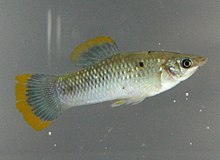Poecilia sphenops
| Molly | |
|---|---|

| |
| Male molly | |
| Scientific classification | |
| Domain: | Eukaryota |
| Kingdom: | Animalia |
| Phylum: | Chordata |
| Class: | Actinopterygii |
| Order: | Cyprinodontiformes |
| Family: | Poeciliidae |
| Genus: | Poecilia |
| Species: | P. sphenops
|
| Binomial name | |
| Poecilia sphenops (Valenciennes, 1846)
| |
| Synonyms[2] | |
|
Synonymy
| |
Poecilia sphenops, called the Mexican molly or simply the molly, is a species of poeciliid fish native to Central America.
P. sphenops is placed in the subgenus Mollienesia (mollies) according to the prevailing taxonomic classification of species within the genus Poecilia, and more precisely within the shortfin molly clade, so named because they have a shorter dorsal fin than the sailfin mollies. All shortfin mollies were once considered local variants of a highly polytypic P. sphenops species distributed from the Río Grande basin in north-eastern Mexico to the coast of Venezuela, but currently prevailing view is that the shortfin mollies constitute the P. sphenops species complex of around 13 distinct species. The P. sphenops complex is sometimes further divided into a P. sphenops complex comprising species from the Atlantic slope and a P. mexicana complex from the Pacific slope.[3] P. sphenops is frequently confused with P. mexicana;[4] the two species, as well as the respective complexes, differ in the shape of their inner jaw teeth, which are tricuspid in P. sphenops and unicuspid in P. mexicana.[3]
P. sphenops occurs in both the Atlantic and Pacific slope of Mexico and the northern parts of Central America.[5] On the Atlantic side it ranges from the Palma Sola River in the north to the basin of the Coatzacoalcos River and the headwaters of the Grijalva River in the south. On the Pacific slope it is distributed from the middle of the Río Verde basin in the state of Oaxaca to western Honduras and northern Guatemala.[6][7] P. sphenops frequently occurs together with P. mexicana, but in short coastal streams the former tends to occupy upstream and the latter downstream habitats.[7]
P. sphenops has been introduced outside of its native range through escapes and intentional releases by aquarists and fish farms. [8][9] It is considered naturalized in the US states of Montana and Nevada as well as in Puerto Rico and reported from California and Arizona, but some or all of these populations may turn out to represent another species of the P. sphenops complex.[10]
P. sphenops inhabits freshwater and brackish habitats,[5] with typical habitats including rivers, ponds, lagoons, roadside ditches, and creeks. [7] It is particularly widespread in creeks, and may be found in both lowlands and uplands. It occurs in stagnant water as well as in waters with slight and moderate flow. Such waters may be clear, turbid, or muddy, and are typically not deeper than 1 m (3 ft 3 in). The habitats may feature substrates of marl, clay, silt, mud (which is often deep), rock or bedrock. Some of the habitats are devoid of vegetation, while in others algae (e.g. Chara) and plants such as Lemna, Nasturtium, fine-leaved Potamogeton, Sagittaria, and Typha species are abundant.[7] Algae and diatoms form a significant part of the diet of P. sphenops.[7]
P. sphenops survives in temperatures ranging from 10.8–11.8°C to 38.8–39.5°C when acclimated in a range of 20–35°C.[11] Young fish have been captured from January to August, indicating that the species reproduces throughout much of the year. In rivers the adults congregate close to the banks, while the fry stay in very shallow water.[7]
P. sphenops can grow to 84 mm (3.3 in) standard length[7] or 100 mm (3.9 in) total length, but is usually smaller.[10]
References
[edit]- ^ Matamoros, W.A. (2019). "Poecilia sphenops". IUCN Red List of Threatened Species. 2019: e.T191753A2002434. doi:10.2305/IUCN.UK.2019-2.RLTS.T191753A2002434.en. Retrieved 19 November 2021.
- ^ Froese, Rainer; Pauly, Daniel (eds.). "Poecilia sphenops". FishBase. June 2024 version.
- ^ a b Alda, Fernando; Reina, Ruth G.; Doadrio, Ignacio; Bermingham, Eldredge (2013). "Phylogeny and biogeography of the Poecilia sphenops species complex (Actinopterygii, Poeciliidae) in Central America". Molecular Phylogenetics and Evolution. 66 (3): 1011–1026. doi:10.1016/j.ympev.2012.12.012.
- ^ Gómez-Márquez, José L.; Peña-Mendoza, Bertha; Guzmán-Santiago, José L. (2016). "Reproductive biology of Poecilia sphenops Valenciennes, 1846 (Cyprinidontiformes: Poeciliidae) at the Emiliano Zapata Reservoir in Morelos, Mexico" (PDF). Neotropical Ichthyology. 14 (2). doi:10.1590/1982-0224-20140127. ISSN 1679-6225. Retrieved 7 January 2025.
- ^ a b Palacios, Maura; Voelker, Gary; Arias Rodriguez, Lenin; Mateos, Mariana; Tobler, Michael (2016). "Phylogenetic analyses of the subgenus Mollienesia (Poecilia, Poeciliidae, Teleostei) reveal taxonomic inconsistencies, cryptic biodiversity, and spatio-temporal aspects of diversification in Middle America". Molecular Phylogenetics and Evolution. 103: 230–244. doi:10.1016/j.ympev.2016.07.025. Retrieved 2025-01-07.
- ^ Bagley, Justin C.; Alda, Fernando; Breitman, M. Florencia; Bermingham, Eldredge; van den Berghe, Eric P.; Johnson, Jerald B. (2015-04-07). "Assessing Species Boundaries Using Multilocus Species Delimitation in a Morphologically Conserved Group of Neotropical Freshwater Fishes, the Poecilia sphenops Species Complex (Poeciliidae)". PLOS ONE. 10 (4): e0121139. doi:10.1371/journal.pone.0121139. ISSN 1932-6203. PMC 4388586. PMID 25849959.
- ^ a b c d e f g Miller, R.R.; Minckley, W.L.; Norris, S.M. (2005). Freshwater Fishes of México. University of Chicago Press. pp. 238–239. ISBN 978-0-226-52604-1. Retrieved 2025-01-07.
- ^ Dill, W.A.; Cordone, A.J. (1997). "History and status of introduced fishes in California, 1871-1996" (PDF). Fish Bulletin. California Department of Fish and Game. Retrieved 7 January 2025.
- ^ Lee, David S.; Gilbert, Carter R.; Hocutt, Charles H.; Jenkins, Robert E.; McAllister, Don E.; Stauffer Jr., Jay R. (1980). Atlas of North American Freshwater Fishes. North Carolina State Museum of Natural History. p. 651. ISBN 0917134036.
- ^ a b Nico, Leo; Schofield, Pamela J.; Neilson, Matt; Loftus, Bill (24 October 2016). "Mexican Molly (Poecilia sphenops)". USGS Nonindigenous Aquatic Species Database. Retrieved 7 January 2025.
- ^ Hernández-Rodríguez, Mónica; Bückle-Ramirez, L. Fernando (2010). "Preference, tolerance and resistance responses of Poecilia sphenops Valenciennes, 1846 (Pisces: Poeciliidae) to thermal fluctuations". Latin American Journal of Aquatic Research. 38 (3): 427–437. doi:10.3856/vol38-issue3-fulltext-7. ISSN 0718-560X.

